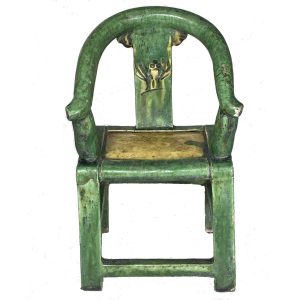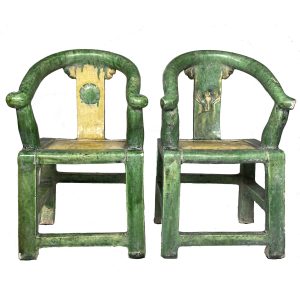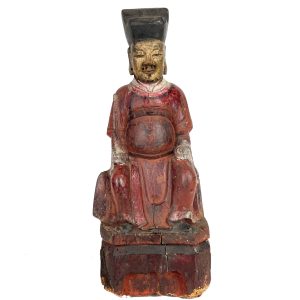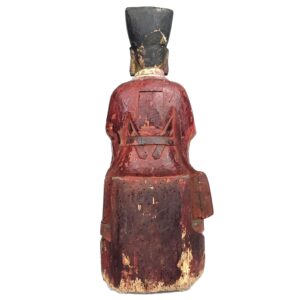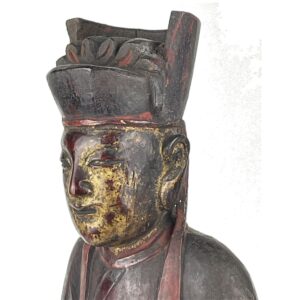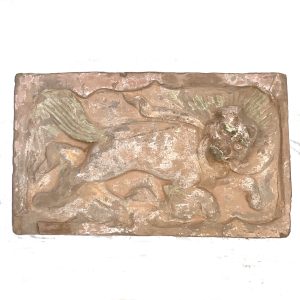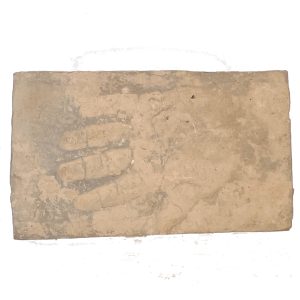-
Sale!


$395.00 Original price was: $395.00.$305.00Current price is: $305.00.
H: 2.5″ W: 4.5″ D: 2.375″ | FREE SHIPPING WITHIN CONTINENTAL U.S.!
This diminutive mingqi pig is totally charming and fanciful with an iridescent glaze and would be especially appealing as a send off for the deceased to the nether world or in a contemporary setting. Pigs were especially prized and images were often included as items the deceased would need to live comfortably in the after life.
-
Sale!


$425.00 Original price was: $425.00.$250.00Current price is: $250.00.
Ht: 8.25″ W: 3″ D: 2.125″ | FREE SHIPPING IN CONTINENTAL US!
Dressed in a red robe with a high neck collar, extremely wide sleeves extending below the knees and a belt around his waist, this ancestor figure portrayed as a civilian official standing on a rectangular base with hands together wearing a long civil official’s robe that extends to his shoes but has no rank badge indicated.
-
Sale!


$595.00 Original price was: $595.00.$425.00Current price is: $425.00.
H: 16.375″ W: 13.625″ D: 5.75″ | FOR SHIPPING INFORMATION CONTACT US AT 213-568-3030 or [email protected]
This intricately carved black and heavily gilt antique cabinet is a fine example of a Straits Chinese furniture made in Guangdong for the Southeast Asia market. Carved openwork panels with phoenixes and lotuses are symbolic wishes for harmony, blessings, rank, good fortune; outstretched wings wish for harmonious marriage, many sons and the inside decoration a wish for status and successful career. Although flamboyant for todays taste, it is a unique accent piece and gift for newly weds.
-


$395.00
In China a set of earthenware Zodiac attendant figures was made as a 12 piece grouping, with each figure holding a small calendar animal with each year represented by a different animal – rat, ox, tiger, rabbit, dragon, snake, horse, goat, monkey, rooster, dog, and pig or boar – in a repeating 12-year cycle. Although…
-
Sale!


$685.00 Original price was: $685.00.$395.00Current price is: $395.00.
H: 7.375″ W: 4.375″ D: 3.75″ | FREE SHIPPING WITHIN CONTINENTAL U.S.!
Horseshoe chairs were considered a sign of rank used by officials and often ancestral figures were portrayed sitting in them to reflect their high status. This well-modeled green glaze ceramic mingqi of a horseshoe chair is decorated with a yellow glaze imitating caning and the decorative carved circular design on the splat. It pairs well with item Ming Earthenware Horseshoe Chair 3331. This would be a fine addition to a collection of antique ceramics or simply a beautiful decorative piece to brighten a small space.
-
Sale!


$875.00 Original price was: $875.00.$475.00Current price is: $475.00.
H: 15.5″ W: 6.125 ” 4.125 D: ” | FREE SHIPPING WITHIN CONTINENTAL U.S.!
This carved ancestor figure portrayed as an official sits on a backless chair with a decorative pedestal in official’s attire: a high collared red robe, double belt above and below his ample stomach and holding a long slender curved hu-tablet, all signs of his office and status. He is vibrantly painted in red, the color of fu, as a wish for prosperity and status.
-


$985.00
H: 15″ W: 6.5″ D: 5.5″ | EMAIL [email protected] OR CALL 213-568-3030 FOR SHIPPING COST
This excellently carved civilian official with gilt highlights was commissioned by a family to place on a home altar for veneration and to impress those who viewed it. The imposing ancestor figure grasps his belt of office to show his pride in passing examinations to become a civil official, which leads to a life of rank and prosperity for him and his family. Statues like this are an affirmation of persistence, success, status and power and they honor those who display these characteristics.
-


$295.00
While major deities such as Guandi were officially sanctioned by government and religious authorities, many popular deities and historic figures were integrated into Popular Religion beliefs where they were assimilated and greatly modified with local traditions and iconographic depictions such as this. We assume this is Guandi, one of the most revered Chinese deities based…
-


$215.00
Images of Taoist priests were often placed on a home altar along with other spiritual images, ancestral tablets and ancestor figures to honor the departed family members, practice familial piety and ancestor-worship, and request good fortune to the family dwelling and its household. Priests were called daoshi (道士 “master of the Tao”) identified by his…
-
Sale!


$485.00 Original price was: $485.00.$395.00Current price is: $395.00.
The Song dynasty (960–1279) is considered the most culturally brilliant era in later imperial Chinese history. A massive expansion during this dynasty produced government, public and religious buildings and tombs with walls decorated with earthenware unglazed mold-made brick tiles. Some were purely decorative and others were wishes for happiness and comfort in the deceased’s afterlife…
-

$325.00
H: 12.25″ W: 8.5″ D: 2.25″ | CALL FOR AVAILABILiTY
Timor masks are rare, intense, characterized by large roughly cut eyes and sometimes have no teeth. This one is not completely black from being stored in house rafters and also has no animal hide with hair attached to it. Its surface has darkened unevenly and there are white bits of white especially on the front. Threatening due to its lack of teeth, asymmetrical eyes and their lack of balance, ancestral masks are used in offering rituals designed to drive off malevolent spirits, scare enemies and perform ritual ceremonies and war celebrations.
Additional Information: This rare vintag
End of content
End of content









